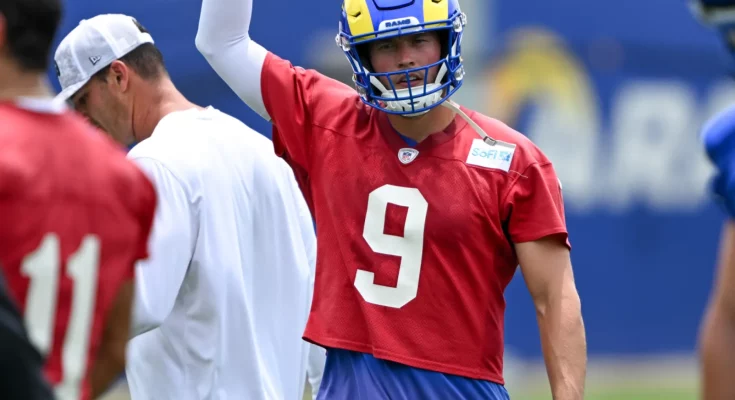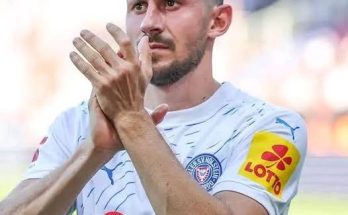Los Angeles Rams quarterback Matthew Stafford, long considered the cerebral and physical anchor of the franchise’s offense, will remain sidelined longer than expected as he continues to deal with back soreness. The update came directly from head coach Sean McVay on Saturday, who indicated that Stafford will not return to practice next week as previously anticipated, casting a cloud of uncertainty over the Rams’ preseason plans and raising broader questions about the quarterback’s durability heading into what many view as a critical season for the team’s trajectory.
Stafford, now in his fourth season with the Rams, has battled a string of nagging injuries since arriving in Los Angeles via trade from the Detroit Lions in 2021. Though he helped deliver a Super Bowl in his first year with the team, the years since have been turbulent. He’s played through elbow tendinitis, concussion-related symptoms, and spinal contusions—injuries that speak to his toughness but also hint at a body that has absorbed significant wear over more than a decade and a half of NFL punishment. The latest setback—a recurrence of back soreness—has prompted the Rams’ medical and coaching staff to exercise caution. While the team had hoped he would return to the field for reps next week, McVay’s remarks suggest the organization is shifting to a more conservative timeline.
The importance of Stafford to the Rams’ offensive structure cannot be overstated. Despite advancing age and a diminished supporting cast compared to the star-studded Super Bowl LVI roster, he remains the team’s best shot at consistent quarterback play. He’s the engine of McVay’s system, a player whose understanding of complex coverages and route timing has allowed the coach to expand his playbook in ways he couldn’t during the early years of his tenure in Los Angeles. A setback in Stafford’s health creates ripple effects across the entire roster—from offensive line configurations to receiver chemistry to running back pass protection assignments.
This development is especially frustrating for the Rams, who were looking to build early-season momentum in what will be one of the NFL’s most competitive divisions. After narrowly missing the playoffs last year, expectations for 2025 are modest but hopeful. With young stars like Puka Nacua, Kyren Williams, and an increasingly confident defense anchored by rising talents, the Rams are trying to strike a delicate balance between short-term competitiveness and long-term roster development. Stafford’s absence, even in the preseason, complicates this vision. Practice time, especially in McVay’s notoriously light-contact training camp structure, is at a premium. Every rep that Stafford misses is a rep that goes uncalibrated between quarterback and skill players—timing patterns, cadence familiarity, audibles at the line. These are often the difference-makers in tightly contested games, particularly against elite defensive units like the 49ers or Seahawks.
From a broader strategic standpoint, the Rams may now face a difficult decision. Should Stafford’s soreness linger or evolve into something more structurally problematic, they must weigh whether to ramp up their investment in backup quarterback development. Currently, the team’s depth chart includes Stetson Bennett and Jimmy Garoppolo, the latter having been signed to provide an experienced insurance policy. Garoppolo, though, comes with his own medical history—frequent absences in San Francisco and a difficult final campaign in Las Vegas where he never truly found rhythm or form. Still, his familiarity with West Coast concepts and game management skills offer McVay a safer floor than most backups in the league.
Bennett, on the other hand, remains a wildcard. The former Georgia standout missed nearly all of last season due to personal reasons but has rejoined the team with hopes of regaining form and trust. By all accounts, Bennett has flashed moments of promise in early offseason drills, though consistency remains a challenge. The possibility of meaningful preseason snaps for Bennett now increases, and depending on Stafford’s recovery timeline, the Rams may be forced to accelerate Bennett’s development plan. That shift would not only impact offensive reps but could also place the entire playbook in a temporary state of flux, as the team might need to simplify schemes and limit options to accommodate an inexperienced signal caller.
McVay has historically been one of the league’s most cautious coaches when it comes to preseason exposure for starters, a philosophy shaped by both injury prevention and belief in controlled practice over exhibition performance. In that context, Stafford missing practice might not be alarming by itself. However, this is more than load management. The phrasing of “back soreness” is ambiguous by nature. It could mean tightness, inflammation, or something far more serious like a disc or nerve issue. For a 36-year-old quarterback who has already endured spinal cord injuries in recent years, even minor symptoms can be precursors to more serious complications. The team’s public stance on caution likely mirrors private concern about not triggering a long-term absence that could derail the entire season.
Rams fans have grown accustomed to Stafford playing through pain. His toughness is well-documented—from playing with a separated shoulder in Detroit to leading game-winning drives through pain-riddled campaigns in L.A. That grit has made him beloved among teammates and respected league-wide. But at some point, grit collides with biology. The Rams’ top brass, including general manager Les Snead, has to grapple with the reality that they’ve built an offense around a quarterback who may not be able to physically handle a full season’s load in the same way he once could. They’ve put off drafting a high-round successor in each of the last three drafts, preferring instead to invest in offensive line protection and weapons to maximize Stafford’s remaining window. That strategy, while reasonable given his past performance, now feels increasingly risky with every missed rep.
The timing of the setback also complicates locker room psychology. Training camp is when team identity takes shape. Leaders set the tone, rookies learn the culture, and internal hierarchies solidify. When your franchise quarterback is absent from that process, it can unintentionally disrupt chemistry. Offensive players like Nacua and Cooper Kupp benefit enormously from timing-based repetition with Stafford. Even minor tweaks to release points or checkdown rhythm can have outsized effects during the season. Furthermore, McVay’s schemes often rely on pre-snap motion and post-snap deception—both of which require ironclad communication between quarterback and receiver. That communication cannot be replicated in the film room or simulated on the sideline. It must be forged in practice, in huddles, in broken plays, in trial and error. And right now, the Rams are being denied that essential time.
Defensively, the team will also feel the void. While Stafford doesn’t take reps on defense, his presence in practice indirectly boosts the defense’s quality by simulating game-level pressure. Practicing against a quarterback of Stafford’s caliber helps young defenders sharpen their reads and reaction times. Without him, the defense will get plenty of reps against Garoppolo or Bennett, but the level of complexity and challenge may dip—at least until those players catch up mentally and physically.
From a media and public relations standpoint, the Rams are navigating this situation with cautionary optimism. McVay’s tone has not been panicked, but it’s also lacked definitive reassurance. The message seems to be: don’t overreact, but also don’t expect miracles. That ambiguity will naturally fuel speculation—especially in Los Angeles, where sports radio and social media chatter can turn rumor into narrative in a matter of hours. The Rams, already playing in the shadows of teams like the Chargers and the high-profile USC Trojans, can’t afford prolonged stretches of uncertainty at quarterback if they want to hold the city’s attention and compete for playoff relevancy.
Looking ahead, the next two weeks will be critical. If Stafford does not progress or continues to sit out team activities, McVay may be forced to reconfigure his preseason gameplan entirely. That could include limiting offensive install complexity, giving more reps to third-string quarterbacks, or even exploring veteran free agents should the situation deteriorate further. In a league where quarterback continuity is often the dividing line between playoff teams and cellar dwellers, the Rams find themselves at a crossroads. They have their franchise quarterback under contract, their head coach still among the league’s brightest, and a core of intriguing young players ready to take the next step. But without a healthy Matthew Stafford, the entire operation rests on shakier ground than anyone in Los Angeles would like to admit.
For now, fans and analysts alike will wait for the next update—hopeful that soreness is just soreness, and not a harbinger of something more structural or season-threatening. But as history has shown in the NFL, the difference between a minor ailment and a major setback often lies in how the team handles the first few days of recovery. The Rams are walking a delicate line, and the entire league is watching.



